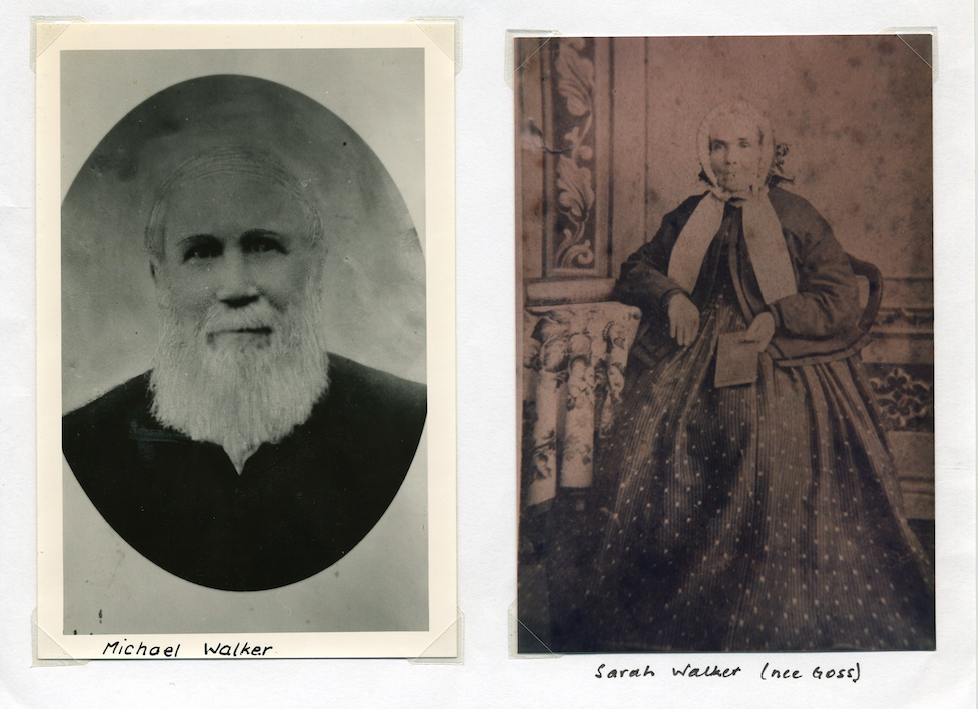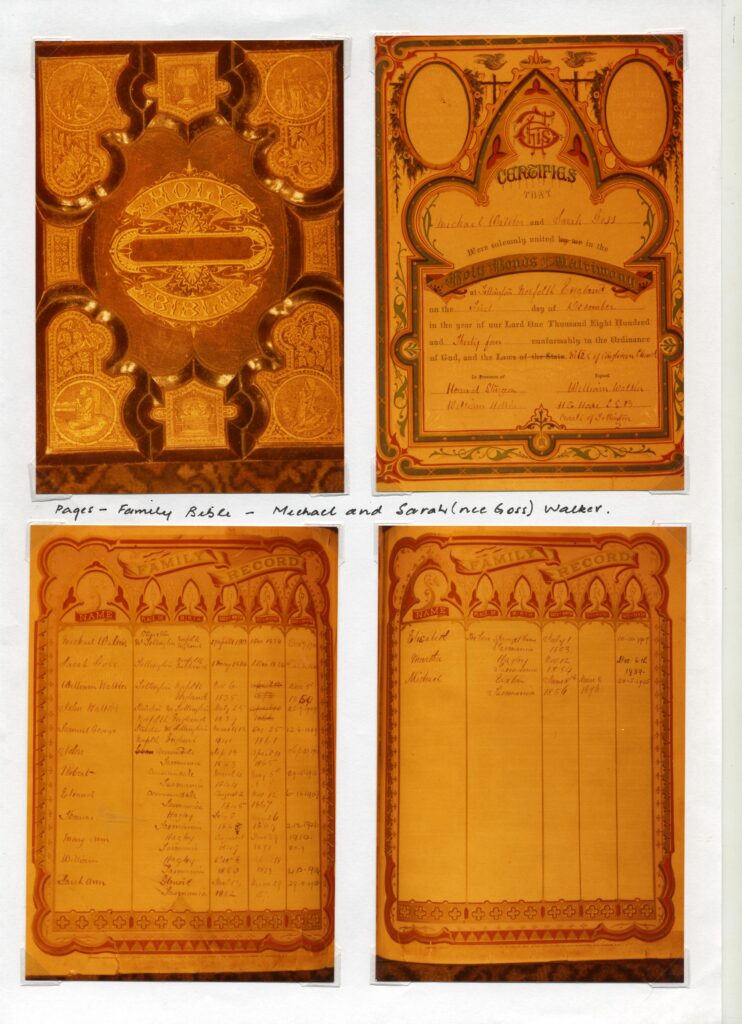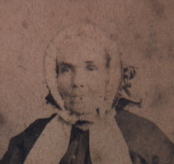Michael Walker (1813-1900) and Sarah (nee Goss) Walker (1814-1888)

Beginnings
Michael and Sarah, my g.g. grandparents, arrived at Launceston, Tasmania on 31 March 1842 after leaving on 8 November 1841 from Gravesend, a port on the Thames, 21 miles from central London. They were travelling aboard the sailing ship ARAB and left carrying 205 emigrants and five paying passengers, besides the crew and cargo. The emigrants were mostly rural workers from Somerset, England.
The ARAB was a three masted barque of 296 tons and had been built in 1827. Its master was Captain William Westmorland. It was a very trying voyage mostly due to stormy conditions encountered. During the voyage three deaths and five births were recorded.
Michael and Sarah had both grown up at Tottington, Norfolk and married there on 1 December 1834. Michael was recorded as an agricultural labourer and Sarah a domestic, with Michael being 21 years of age and Sarah a year younger. Family stories relate they had been sweethearts from their young years. Clearly, they belonged to the working class.
At Tottington, three sons were born to the family, William (1835), John (1839) and Samuel George (1841). A further 10 children would be born in Van Dieman’s Land.
Both the Walker and Goss families had lived in the Tottington region for generations. Michael was the sixth child of John Walker (1778-1870) and Mary Ann (nee Clarke) (1785-1872) and had nine siblings. Sarah was the eighth child of Thomas Goss (1768-1856) and Hannah (nee Burroughs) Goss (1779-1852). She had 11 siblings. Sarah and three of her brothers and their families would all emigrate to Van Diemen’s Land, later known as Tasmania, Australia.
Emigration
England in the 1840s was in severe depression and had a high unemployment rate. Wages were low resulting in much poverty. There was a clamour to direct the “surplus” population to emigrate, with Van Diemen’s Land one of the places being promoted. Sarah’s brother John (b.1804), with wife Ann (Ayers) and children, had emigrated here (Van Diemen’s Land) arriving December 1841. Thomas (b.1807) and his wife Martha and four children reaching Geelong, Victoria on 4 May 1854 but soon moving to Launceston, Van Diemen’s Land. The last to arrive being Sarah’s brother, Robert (b.1818) and his wife Susannah and their two children, reaching Launceston, mid-June 1855.
The Voyage
A diary record of the voyage is on hand and details the events, trials and hardships encountered by those travelling. It was kept by a passenger, William Johnstone, from departure to arrival at Launceston. It is a typed copy but of poor print quality making it unreadable in places.
Departure was planned for 1 November 1841 however due to “circumstances” (not explained) the ARAB was detained there during the week. The passengers were taken aboard on Saturday, 6 November and setting sail on Monday, 8 November 1841, but delayed till 10am. due to fog.
On reaching Dral (Deal?) a port town where the North Sea and English Channel meet, and entrance to the Thames, they anchored there till Sunday 14 November because of adverse weather. Soon after getting underway, they were hit by a violent storm. William Johnstone recorded the event as follows –
“…… the vessel pitching and tossing most cruelly and waves crashing over the bulwarks. The between decks were the emigrants, were all stowed away (sometimes a man and his wife and two children in one bed) were in a most horrible condition. The seas had washed down the hatchways and the floor a complete pond, many of the beds drenched through and through. In addition to these delights, with some four or five exceptions, they were all violently seasick – all calling out for brandy ……… The squall had come on so suddenly that their boxes were all adrift, flying about from one side to the other, with nearly 50 whining sick squalling children to complete their misery”.
William further noted
“The emigrants, chiefly Somersetshire labourers, all lamented their foolishness in leaving home”. “Sleep at night was out of the question. The awful creaking of every part of the vessel, hollering of the sailors, and roaring of the sea, with noises of every description completely prevented it. The Captain who said he had never had such a thrashing in the Channel before, did not take off his clothes for several days together, remaining on deck nearly all night.” “With the gale not abating on Sunday, the Captain determined to change his course for Falmouth and accordingly on Monday morning we were delighted by finding ourselves just entering Carrick Heads. Many other vessels had sought the shelter of the harbour – one with bulwarks washed away, another with a broken mast gone and several, more or less damaged”.
The Falmouth visit gave opportunity for recovery and the purchase of fresh provisions, with much of the livestock and poultry having been swept away in the storm. These provisions had been put on board to provide fresh food for the 5 passengers and the main crew, Captain William Westmorland, Chief Officer Mr. Plater, and Surgeon Mr Corbould. The provisions loaded at Gravesend were, 13 sheep, 13 pigs, 10 dozen fowls, 1 dozen geese, I dozen turkeys, 2 dozen ducks and one goat (for milk). During the voyage 13 little pigs were born. Their daily drinks taken on board were, bottled ale, bottled porter, sherry, port, claret, brandy, rum, Geneva, gin, Hollands, lime juice, tea and coffee.
The voyage resumed from Falmouth on Thursday, 25 November 1841.
Another severe storm was experienced near the Cape of Good Hope with William recording on 7 February 1842,
“A very heavy sea – pitching and tossing awfully, the Skipper thought even worse than in the Channel – poor emigrants all sadly ill, and a repetition of many of the early scenes”.
Ship Life
On boarding the Captain quickly laid down the rules to the emigrants. Many had gathered on the poop deck from where they were unceremoniously expelled by the Captain, who commanded them never to have the imprudence to show their faces there again.
It was made clear that they were mostly to remain in their cabins. There were some exceptions, being permitted to be on deck for Sunday’s Divine Service and for the collection of food from the galley. The children were permitted to be on deck for two hours of a morning to attend learning programs.
The deaths of three children occurred, the date given and some brief details. On 7 December 1841 William recorded
“… in the evening one of the migrant’s children died, having been ill ever since it came on board, and was buried at 8 o’clock the next morning, the Surgeon acting as Chaplain”.
He was committed to the deep off the coast of France. This was John Walker, the two year three month old son of Michael and Sarah. Family stories say that he died from an asthma attack.
The other deaths occurred on 13 January 1842 and 7 February 1842.
At the end of the voyage William gave a summary on the emigrants and the trip
“Our greatest annoyance was the Emigrants – a most awful set, about 20 respectable out of the whole number. Scenes are daily occurring, which tho’ unnecessary to describe, yet most revolting – and scarcely be prevented. Fighting and swearing from morning till night – I would advise no-one to come out in an Emigrant Ship when another is in the berth. They were chiefly agricultural labourers from Somersetshire, who had been earning upon average, seven shillings and sixpence a week, on which they supported their wives and families.”.
The Family at Van Diemen’s Land/Tasmania
After arrival at Launceston, Tasmania the family settled near Perth on “Annandale”, at that time a thousand acre farm on the Western side of the Midland Highway, between Gibbet Hill and Breadalbane and extending west as far as “Jessiefield”, later known as Pateena. Van Diemen’s Land had been established as a convict settlement and colony in 1803 with the 1838 muster recording 18,000 convicts and 28,000 free settlers. Around 5,000 convicts a year, at peak, were being received, with some 72,000 arriving over the 50 years of transportation.
Michael’s occupation at the birth of his son, the second John Walker, on 13 September 1842, is farm servant. Two further births were recorded at Annandale, Robert (1845) and Eleanor (1846) their first daughter.
Not far from their home was a gibbet and was detested by Sarah and frequently found it a difficulty when passing. It was situated by the roadside and was constantly in use, bodies of convicted criminals, who had been hanged, would be suspended by chains for all to see as a deterrent to others. Often they would be covered with tar so as to extend their body keeping.
Later in 1846 the family moved to Hagley, Tasmania where Michael rented a farm from the Lyttleton estate, a 500 acre property known as “Greenhills”. In addition to farming “Greenhills”, Michael had charge of the adjoining property of “Hagley House”, then owned by Isaac Noake of Longford.
In the Census taken on 3 January 1848, for Hagley the residents were recorded and identifies Michael and Sarah living there with their five children, plus eight single males, 3 with Tickets of Leave and 1 in private employment, residing in a wooden house owned by Rev. R.R. Davies (the Church of England minister at Longford) with the Householder being Isaac Noake who was not living there.
Six children were born to Michael and Sarah during there stay at Hagley, Thomas (1848), Mary Ann (1849), William (1850), Sarah (1852), Elizabeth (1853) and Martha (1854).
The William born on 8 December, 1850, was named after his eldest brother, who had lost his life one year and four days previously at barely 15 years of age in an accident at Exton when a cart overturned.
Towards the end of 1854 the family moved to Exton, where Michael spent the remaining forty six years of his life. He rented “Ti-tree Farm”, which was part of the Rev. Samuel Martin’s estate. Their last child Michael, was born at Exton on 8 June 1856.
The period from 1855 to 1888 may be regarded as Michael’s heyday. His friends and neighbours accepted him as a leader in church and municipal affairs, and he appears to have been regarded as a prosperous and progressive farmer. He was an employer and a man of substance and had crossed a great gulf from the position of labourer to that of a gentleman, a title applied to him in his latter years.
Sarah was a weighty person and in her later years became an invalid and was confined to her bed. The assistance of a housekeeper, Mary Patfield, was obtained and following Sarah’s death, became Michael’s second wife, marrying at nearby Westbury on 8 January, 1890
Following Mary’s death, on 2 September 1892, Michael married for a third time on 18 March 1893 to a widow, Margaretta Shaw (1829-1906).
Michael died on 9 August 1900 at the age of 88 years and was buried at the Westbury Church of England cemetery, beside his first wife Sarah and their first born son William.
Sarah lost only two of her thirteen children, one at sea and the other as a result of an accident. The other eleven survived to an average age of 68. Her five daughters followed in her footsteps as good mothers and housewives, averaging a dozen grandchildren apiece. Of the first seven of Sarah’s surviving children, six named a child after her, so that at one time the family boasted four first cousins who rejoiced in the name of Sarah Walker, plus two additional first cousins named Sarah Appleby and Sarah Richardson.
Church Associations
A noted feature of Michael, Sarah and family was their strong faith and active participation in the life of the Church.
The first indication is provided by the presentation of a Family Bible just prior to departure by the Rev. Edward Simons, Rector of Sturston, Norfolk. In the Bible which still exists is the inscription –
“This is the true Word of God, which alone can teach you what you must believe, and so to obtain spiritual life here, and eternal life hereafter. Read it with careful prayer to God, for the teaching and help of the Holy Spirit, and it will make you wise unto Salvation through faith, which is in Christ”.

William Johnstone noted in his diary that some of the emigrants spent time reading their Bibles and religious tracts. Although no names are mentioned, may have included Michael and Sarah.
Near where they were living at Perth, the Wesleyans had built a church in 1840 named Salem, which Michael and family began attending. In his memoirs Michael records he came under the influence of the Wesleyan Local Preachers which included a Mr. French (Francis), who was living at Longford and preaching in the area. At Salem, Michael commenced teaching Sunday School classes, which he continued to do for many years.
A number of the descendants of both men were able to claim a relationship to both Michael and Francis French. When the history of each family was completed in the 1980s, of the 8,000 plus names in the Walker book, ”A Goodly Heritage”, around 4,000 of these also appeared in the French/Badcock book, “Go…..Be Fruitful and Multiply”.
On moving to Hagley, Michael records,
“In 1846 I came to Hagley, there was no church of any kind at that time, but we used to meet at Mr. Montgomery’s farm house and hold Services and Class Meetings”.
Michael’s memoirs continue
“In 1854 I came to Exton, it was almost a wilderness, no church and few church going people. Brother Purton, who is now in Victoria, and myself got a few children together in a small cottage and commenced a Sunday School and had cottage prayer meetings. About 12 months after I came to Exton ……… we thought we would try to build a church or chapel at Exton. After some troubles we had a little church built in 1856 and Mr. Woolnough took the services. The Methodist Sunday School was opened in 1854.
Michael and Sarah Walker’s Children
- William – born 1835 at Tottington, Norfolk, died 1849 at Exton, Tasmania
- John – born 1839 at Tottington, Norfolk, died at sea, 7 December 1841
- Samuel George – born 1841 at Tottington, Norfolk, died 1912
- John – born 1842 at Perth V.D.L., died 1909
- Robert Wilson – born 1845 at Perth V.D.L., died 1916
- Ellen/Eleanor – born 1846, at Perth V.D.L., died 1907
- Thomas – born 1848, at Hagley, Tasmania, died 1926
- Mary Ann – born 1849, at Hagley Tas., died 1910
- William – born 1850, at Hagley, Tas., died 1904
- Sarah Ann – born 1852 at Hagley Tas., died 1926
- Elizabeth – born 1853 at Hagley, Tas., died 1917
- Martha – born 1854 at Hagley, Tas., died 1939
- Michael – born 1856 at Exton, Tas., died 1925
By Ivan Badcock – 03 May 2021


Hello Ivan,
Thank you for this valued post.
My name is Paul Dooley. Michael Walker is my maternal GG-grandfather (my G-grandfather is Isaac Simeon Richardson (who married Mary Ann Walker) and my grandfather is Clarence Richardson). I am writing a website of my family ancestry and am currently writing the story of Michael and Sarah Walker. I have met Beverley Richardson and have a copy of her book. I was not aware that Michael’s diary exists. Has it been digitised? Do you know how I could obtain a copy?
I am also a descendant of Michael and Sarah and would also be very interested in seeing Michael’s diary. Has it been digitised? I would also like to know how I could obtain a copy.
Please feel free to email me, my name is Narelle I look forward to hearing from you.
[email protected]